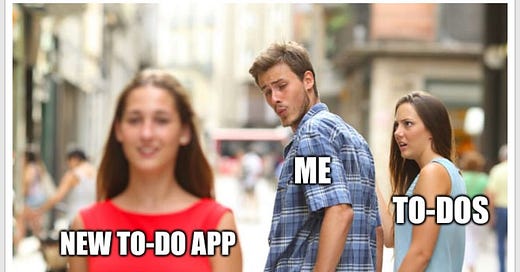The simple answer is read “Getting Things Done” (GTD) by Dave Allen. This book undoubtedly changed my life. I felt a massive gain in productivity just by learning a few things…

Now, most people don’t read the books I recommend, so here’s GTD in a nutshell (with a dash of Bullet Journal):
1) HAVE ONE LIST - GTD requires you have 1 set of to-dos. To aggregate it you have to collect to-dos from everywhere else - email, text, a scrap of paper in your kitchen, a phone call, your notebooks - THERE IS 1 LIST. If you have many lists, your mind is scattered. If you keep things in your head - BAD. If you have multiple notebooks with to-dos - BAD. Emails with random lists - BAD. The reason for all this is they prevent “a mind like water” - you want to get to a spot where you trust your to-do list – if you have many lists, you can’t trust any of them and background anxiety creeps in.
2) WRITE CLEAR NEXT ACTIONS - Break projects down into immediate next actions. When writing your to-dos, they should be actionable. That means no “go to doctor” - BAD. “Google dentist in san francisco and find 3 phone numbers” - GOOD. “Call dentist 1 at XXX-XXXX” - GOOD. Action oriented. It’s amazing how much clarity I get from just doing this one thing. If you are feeling stressed, this is often the reason why.
3) WAIT-FOR & FOLLOW-UP: Once you do something but you’re waiting for someone else, write your to-do as “WF …” (waiting for), or “FU …” (follow-up). For example, you call the dentist and then you write “WF Dentist to call back”
4) HAVE A CALENDAR / REMINDER METHOD: So you have your to-dos, now you need a way to remind yourself for the FUs and WFs. I use the bullet journal (described below) + gmail scheduler to remind myself. Others use calendars. O.G. GTD uses a complex filing system from the 90s with folders. What matters is that you have a reminder on Day X that you have an action item.
4) BULLET JOURNAL: This one isn’t from GTD but it’s helpful. Basically, you need somewhere to write down your next actions. I’ve tried every app known to the App Store. I prefer paper. I now have a minimalist Bullet Journal (“BUJO”) with two pages. One for today: a set of bullet points with next actions for today + a page for tomorrow with bullet point next actions for tomorrow. You do the items for today and new ones + those that you need to follow-up on or wait-for, you add to the tomorrow list.
4.5) SYMBOLS FOR BUJO: BUJO uses various symbols to indicate done / moving to future, etc. I like them. Next actions have “.” next to them. When complete you make the “.” an “x”. Things delayed to tomorrow are “>”. YouTube, Reddit and Instagram are like bullet journal heaven - insane volumes of examples on beautiful details and symbols.
That’s it.
A few final words on to-do systems learned the hard way. *The costs of a to-do system for personal use very quickly outweighs benefits* - one crappy paper list you use regularly is way better than a complex one you never use. After many years (decades?) of trying tools, paper is my go-to. At some point in the future, you’ll see a new tool and think it’s great! It’s not. This will solve everything! It won’t.
The tool isn’t what’s holding you back.
Happy doing!
PS - I’m recording my first few podcasts next week. Should hopefully have my first MVP ready soon.
PPS - I find note taking to also be enjoyable so here is a cheat sheet for that since it’s another benefit of paper.




